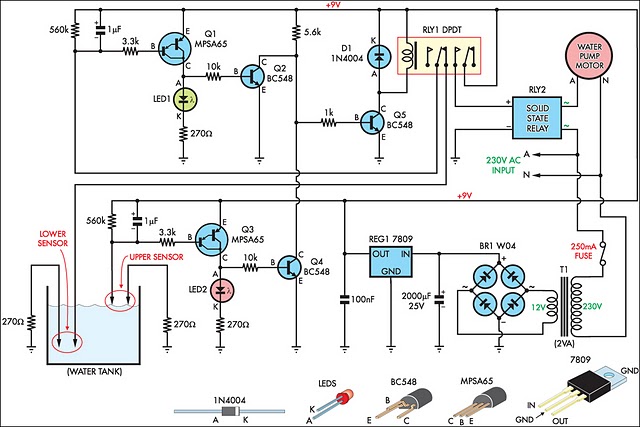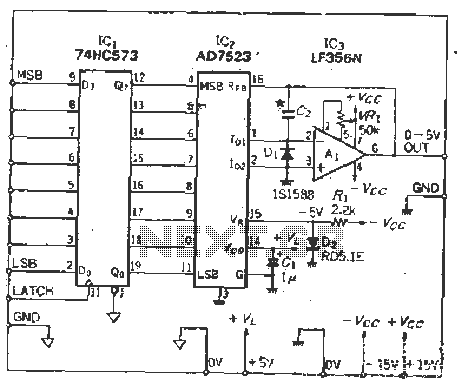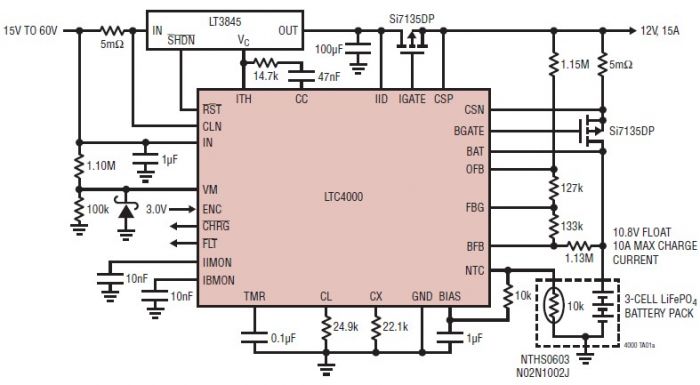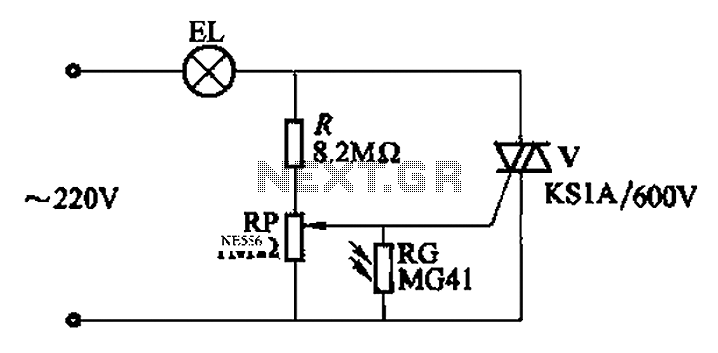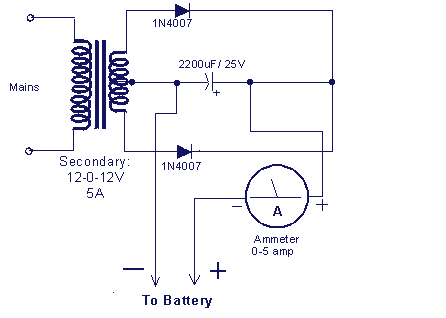
Bidirectional thyristor delay lamp circuit 2
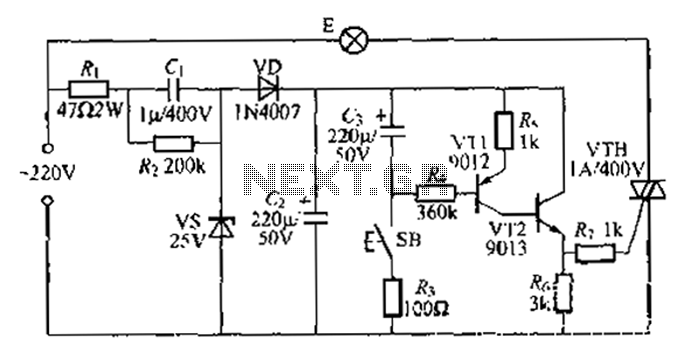
Another method employs a Zhu gall thyristor delay lamp circuit. Typically, a 220V AC supply is used, consisting of a step-down voltage half-wave rectifier circuit. The circuit outputs approximately 25V across the left and right terminals. At this point, the transistors VT1 and VT2 are in the off state, preventing the bidirectional thyristor from receiving a trigger current, which means the lamp remains off. When the lamp is required to light up, a switch (SB) is activated, allowing 25V DC to flow through resistors R1 and R2 to the base of transistor VT1. This provides the necessary bias current, turning on both VT1 and VT2. The thyristor then receives the trigger current, powering the lamp. Meanwhile, capacitor C charges rapidly through resistor R after the switch is released. The stored charge in C keeps VT1 conducting, allowing a small light to remain lit. As the capacitor discharges, VT1 and VT2 revert to their original off state. Eventually, the voltage across resistor R diminishes to zero, reducing the thyristor's conduction angle, which causes the lamp's brightness to fade until it turns off completely. Adjusting the values of resistors R1, R2, and capacitor C can modify the delay time of the circuit as needed.
The Zhu gall thyristor delay lamp circuit effectively uses a combination of AC to DC conversion, transistor switching, and thyristor control to manage the illumination of a lamp. The design begins with a 220V AC input, which is reduced to a safer 25V through a half-wave rectifier circuit. This reduction is crucial for protecting sensitive components and ensuring safe operation. The two transistors, VT1 and VT2, serve as switches that control the flow of current to the thyristor. When the switch SB is activated, it triggers the base of VT1, allowing current to flow through the circuit and subsequently turning on the transistors.
The role of the capacitor C is significant in this circuit. It charges quickly when the switch is closed, and its stored energy helps maintain the conduction of VT1 even after the switch is opened. This characteristic allows for a gradual dimming effect as the capacitor discharges, providing a smoother transition of light output from the lamp. The circuit design can be fine-tuned by altering the resistance values of R1 and R2, as well as the capacitance of C. This flexibility allows for customization of the delay time, making the circuit suitable for various applications where controlled lighting is desired.
The operation of the circuit can be summarized in the following sequence: Initially, when the lamp is off, the transistors are not conducting, and the thyristor remains inactive. Upon closing the switch, the transistors are activated, allowing current to flow and the lamp to light up. Once the switch is opened, the capacitor C maintains the conduction state of VT1, keeping the lamp dimly lit until the capacitor discharges sufficiently. The gradual reduction in voltage across the resistors leads to a decrease in the thyristor's conduction angle, resulting in the lamp slowly fading out. This circuit design exemplifies a practical application of thyristor technology in lighting control systems.Another method uses Zhu gall thyristor delay lamp circuit. Usually, 220V AC via vr), vs, (,, c: isoelectric consisting of step-down voltage half-wave rectifier circuit, in f st able 25V output ends of the left and right straight. At this time the pressure flow la transistor VT1,. VT2 are in the oFF state, bidirectional thyristor tube trigger current, especially in the off state, F does not light the lamp. lights when needed, then ~ F SB, 25v DC via R., Rj to VT1 Almost bias current fed into the base, V1, l, VT2 have been turned on, vrH get trigger current opened, the lamp is powered E-emitting, meanwhile, (, full charge through rapid blood R.
after releasing the SB, r. stored charge by R. dare to VT1 electric, we are still able to maintain VT1 conduction, small lights will go out. with G continues to discharge, VTI, VT2 conduction to the original zoom into nervous state, and ultimately restore the oFF-state, so R. voltage becomes smaller, eventually reduced to zero, the thyristor conduction angle vrH also will be smaller after the moth becomes zero Wei, E light fades until it goes off.
change R., Gs, uh value to change the delay time of the circuit can be adjusted as needed .
The Zhu gall thyristor delay lamp circuit effectively uses a combination of AC to DC conversion, transistor switching, and thyristor control to manage the illumination of a lamp. The design begins with a 220V AC input, which is reduced to a safer 25V through a half-wave rectifier circuit. This reduction is crucial for protecting sensitive components and ensuring safe operation. The two transistors, VT1 and VT2, serve as switches that control the flow of current to the thyristor. When the switch SB is activated, it triggers the base of VT1, allowing current to flow through the circuit and subsequently turning on the transistors.
The role of the capacitor C is significant in this circuit. It charges quickly when the switch is closed, and its stored energy helps maintain the conduction of VT1 even after the switch is opened. This characteristic allows for a gradual dimming effect as the capacitor discharges, providing a smoother transition of light output from the lamp. The circuit design can be fine-tuned by altering the resistance values of R1 and R2, as well as the capacitance of C. This flexibility allows for customization of the delay time, making the circuit suitable for various applications where controlled lighting is desired.
The operation of the circuit can be summarized in the following sequence: Initially, when the lamp is off, the transistors are not conducting, and the thyristor remains inactive. Upon closing the switch, the transistors are activated, allowing current to flow and the lamp to light up. Once the switch is opened, the capacitor C maintains the conduction state of VT1, keeping the lamp dimly lit until the capacitor discharges sufficiently. The gradual reduction in voltage across the resistors leads to a decrease in the thyristor's conduction angle, resulting in the lamp slowly fading out. This circuit design exemplifies a practical application of thyristor technology in lighting control systems.Another method uses Zhu gall thyristor delay lamp circuit. Usually, 220V AC via vr), vs, (,, c: isoelectric consisting of step-down voltage half-wave rectifier circuit, in f st able 25V output ends of the left and right straight. At this time the pressure flow la transistor VT1,. VT2 are in the oFF state, bidirectional thyristor tube trigger current, especially in the off state, F does not light the lamp. lights when needed, then ~ F SB, 25v DC via R., Rj to VT1 Almost bias current fed into the base, V1, l, VT2 have been turned on, vrH get trigger current opened, the lamp is powered E-emitting, meanwhile, (, full charge through rapid blood R.
after releasing the SB, r. stored charge by R. dare to VT1 electric, we are still able to maintain VT1 conduction, small lights will go out. with G continues to discharge, VTI, VT2 conduction to the original zoom into nervous state, and ultimately restore the oFF-state, so R. voltage becomes smaller, eventually reduced to zero, the thyristor conduction angle vrH also will be smaller after the moth becomes zero Wei, E light fades until it goes off.
change R., Gs, uh value to change the delay time of the circuit can be adjusted as needed .
